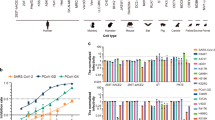Abstract
CORONAVIRUSES, like many animal viruses, are characterized by a restricted host range and tissue tropism1. Transmissible gastroenteritis virus (TGEV), a major pathogen causing a fatal diarrhoea in newborn pig, replicates selectively in the differentiated enterocytes covering the villi of the small intestine2. To investigate the molecular determinants of the infection, we characterized the surface molecule used by the virus for binding and entry into host cells. Here we report that aminopeptidase N, an ectoenzyme abundantly expressed at the apical membrane of the enterocytes, serves as a receptor for TGEV. Monoclonal antibodies were selected for their ability to block infection by TGEV of porcine cell lines. They recognized a brush-border membrane protein of Mr, 150K, which was identified as aminopeptidase N by ammo-terminal sequencing. Two lines of evidence supported the view that the peptidase itself acts as a receptor. First, virions bound specifically to aminopep-tidase N that was purified to homogeneity. Second, recombinant expression of aminopeptidase N conferred infectivity by TGEV to an otherwise non-permissive cell line.
Similar content being viewed by others
Article PDF
References
Siddell, S., Wege, H. & Ter Meulen, V. J. gen. Virol. 64, 761–776 (1983).
Pensaert, M., Haelterman, E. O. & Burstein, T. Arch. Gesamte. Virusforch. 31, 321–334 (1970).
Olsen, J., Sjöström, H. & Norén, O. FEBS Lett. 251, 275–281 (1989).
Gorvel, J. P. et al. J. Cell Biol. 108, 2193–2200 (1989).
Sjöström, H. et al. Eur. J. Biochem. 88, 503–511 (1978).
Kramers, M. T. C. & Robinson, G. B. Eur. J. Biochem. 99, 345–351 (1979).
Maddon, P. J. et al. Cell 47, 333–348 (1986).
Greve, J. M. et al. Cell, 56, 839–847 (1989).
Mendelsohn, C. L., Wimmer, E. & Racaniello, V. R. Cell, 56, 855–865 (1989).
Dveksler, G. S. et al. J. Virol. 65, 6881–6891 (1991).
Kim, J. W., Closs, E. I., Albritton, L. M. & Cunningham, J. M. Nature 352, 725–728 (1991).
Maroux, S., Louvard, D. & Baratti, J. Biochim. biophys. Acta 321, 282–295 (1973).
Olsen, J. et al. FEBS Lett. 238, 307–314 (1988).
Author information
Authors and Affiliations
Rights and permissions
About this article
Cite this article
Delmas, B., Gelfi, J., L'Haridon, R. et al. Aminopeptidase N is a major receptor for the enteropathogenic coronavirus TGEV. Nature 357, 417–420 (1992). https://doi.org/10.1038/357417a0
Received:
Accepted:
Issue Date:
DOI: https://doi.org/10.1038/357417a0
This article is cited by
-
Epidemiology, pathogenesis, immune evasion mechanism and vaccine development of porcine Deltacoronavirus
Functional & Integrative Genomics (2024)
-
Changes in intestinal morphology, number of mucus-producing cells and expression of coronavirus receptors APN, DPP4, ACE2 and TMPRSS2 in pigs with aging
Veterinary Research (2023)
-
Structures of a deltacoronavirus spike protein bound to porcine and human receptors
Nature Communications (2022)
-
Stable trimer formation of spike protein from porcine epidemic diarrhea virus improves the efficiency of secretory production in silkworms and induces neutralizing antibodies in mice
Veterinary Research (2021)
-
Porcine enteric coronaviruses: an updated overview of the pathogenesis, prevalence, and diagnosis
Veterinary Research Communications (2021)



